University Assignment: Children's Rights and Responsibilities
VerifiedAdded on 2020/03/23
|6
|942
|39
Homework Assignment
AI Summary
This assignment explores the fundamental rights and responsibilities of children, focusing on key aspects such as freedom of speech, equal opportunity, and the right to safety. It delves into the UN Convention on the Rights of the Child, examining specific articles related to education, healthcare, fair treatment, and the right to a childhood and a voice. The assignment presents various scenarios that illustrate the practical application of these rights, including issues of access to education, fair treatment in public spaces, and the role of parents and authorities. It emphasizes the importance of guiding children's behavior and ensuring that all children are treated fairly, with references to relevant literature on children's rights and parental responsibilities.
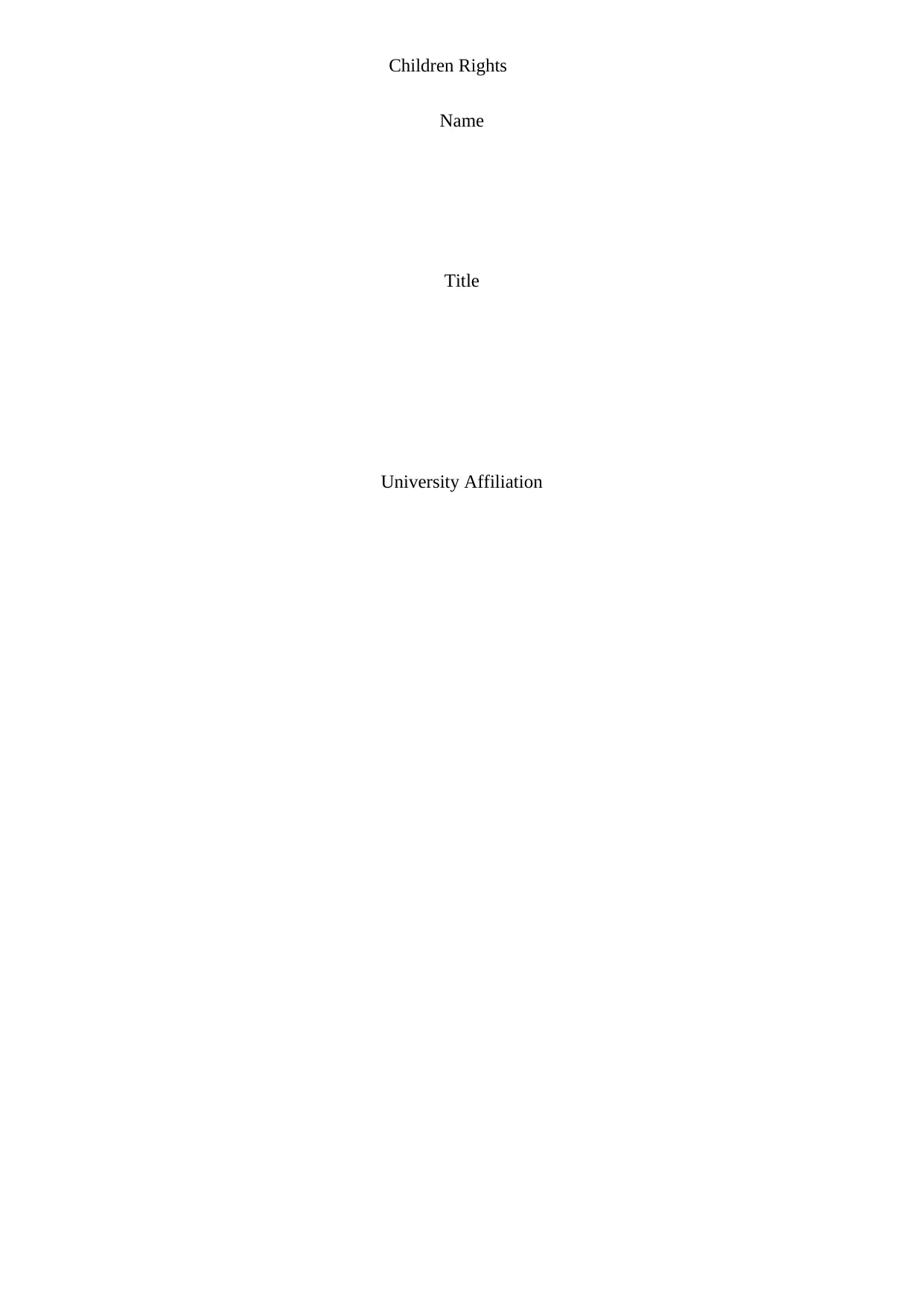
Children Rights
Name
Title
University Affiliation
Name
Title
University Affiliation
Paraphrase This Document
Need a fresh take? Get an instant paraphrase of this document with our AI Paraphraser
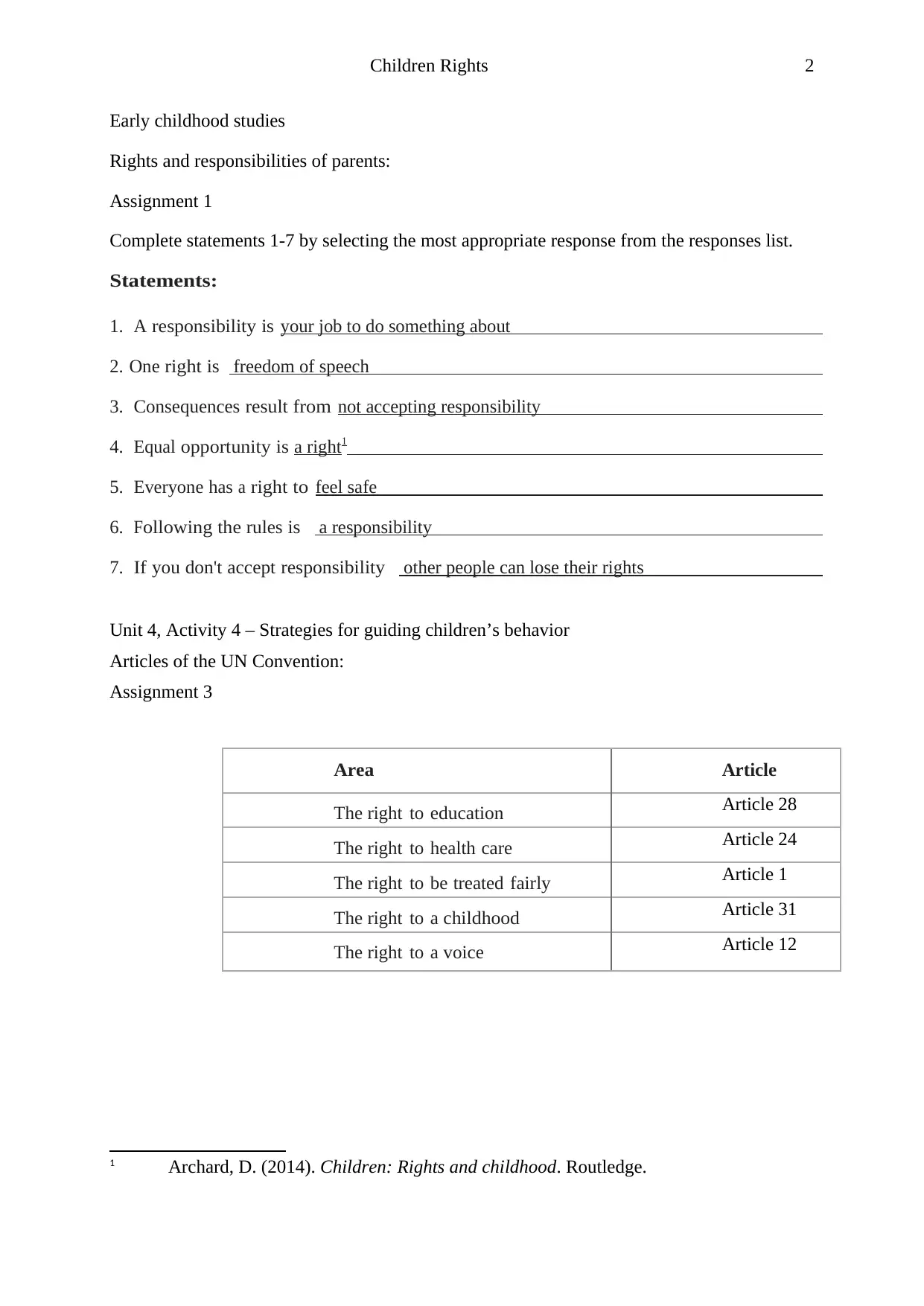
Children Rights 2
Early childhood studies
Rights and responsibilities of parents:
Assignment 1
Complete statements 1-7 by selecting the most appropriate response from the responses list.
Statements:
1. A responsibility is your job to do something about
2. One right is freedom of speech
3. Consequences result from not accepting responsibility
4. Equal opportunity is a right 1
5. Everyone has a right to feel safe
6. Following the rules is a responsibility
7. If you don't accept responsibility other people can lose their rights
Unit 4, Activity 4 – Strategies for guiding children’s behavior
Articles of the UN Convention:
Assignment 3
Area Article
The right to education Article 28
The right to health care Article 24
The right to be treated fairly Article 1
The right to a childhood Article 31
The right to a voice Article 12
1 Archard, D. (2014). Children: Rights and childhood. Routledge.
Early childhood studies
Rights and responsibilities of parents:
Assignment 1
Complete statements 1-7 by selecting the most appropriate response from the responses list.
Statements:
1. A responsibility is your job to do something about
2. One right is freedom of speech
3. Consequences result from not accepting responsibility
4. Equal opportunity is a right 1
5. Everyone has a right to feel safe
6. Following the rules is a responsibility
7. If you don't accept responsibility other people can lose their rights
Unit 4, Activity 4 – Strategies for guiding children’s behavior
Articles of the UN Convention:
Assignment 3
Area Article
The right to education Article 28
The right to health care Article 24
The right to be treated fairly Article 1
The right to a childhood Article 31
The right to a voice Article 12
1 Archard, D. (2014). Children: Rights and childhood. Routledge.
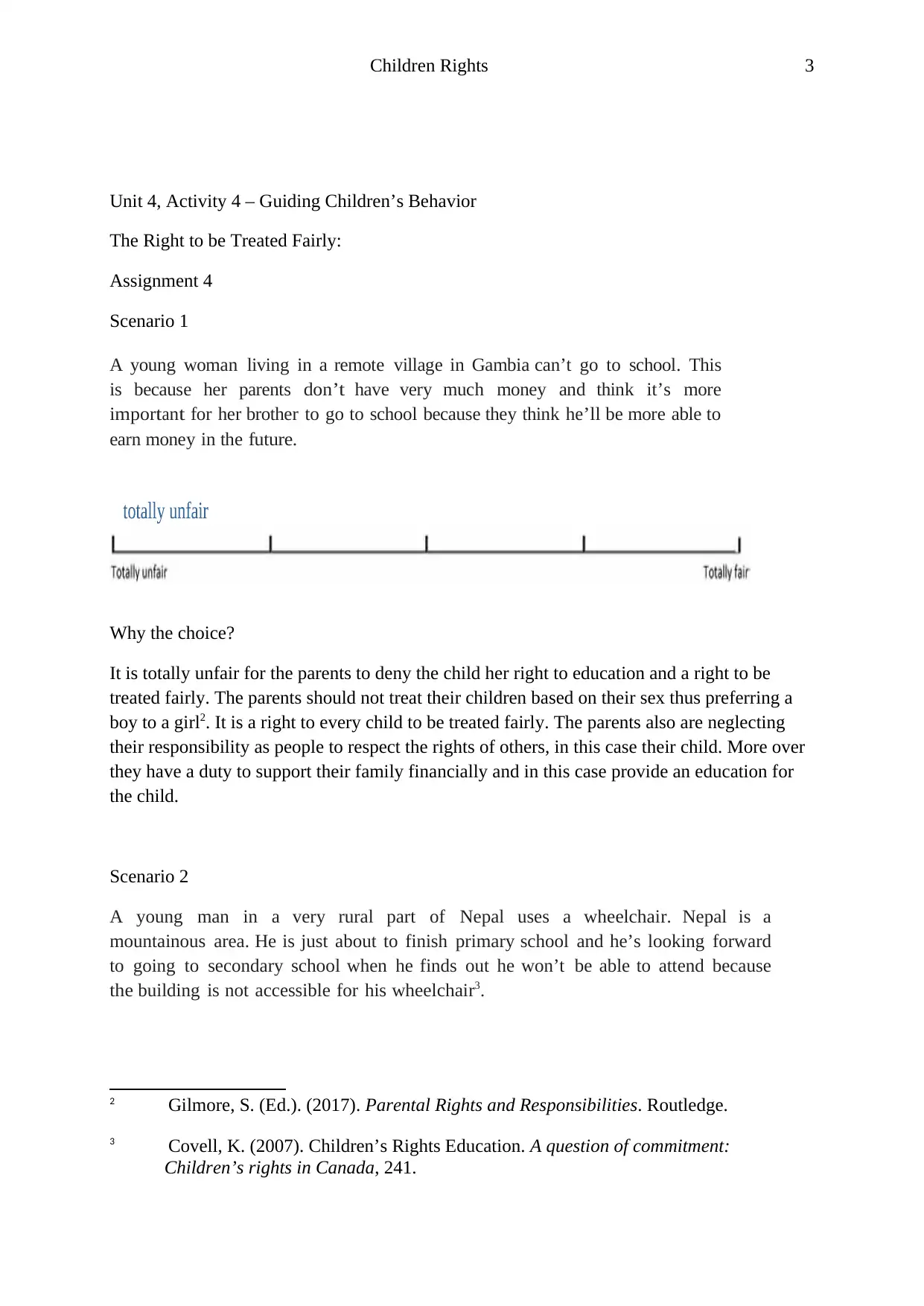
Children Rights 3
Unit 4, Activity 4 – Guiding Children’s Behavior
The Right to be Treated Fairly:
Assignment 4
Scenario 1
A young woman living in a remote village in Gambia can’t go to school. This
is because her parents don ’t have very much money and think it’s more
im p or ta n t for her brother to go to school because they think he ’ll be more able to
earn money in the future.
Why the choice?
It is totally unfair for the parents to deny the child her right to education and a right to be
treated fairly. The parents should not treat their children based on their sex thus preferring a
boy to a girl2. It is a right to every child to be treated fairly. The parents also are neglecting
their responsibility as people to respect the rights of others, in this case their child. More over
they have a duty to support their family financially and in this case provide an education for
the child.
Scenario 2
A young man in a very rural part of Nepal uses a wheelchair . Nepal is a
mountainous area. He is just about to finish primary school and he’s looking forward
to going to secondary school when he finds out he won’t be able to attend because
the building is not accessible for his wheelchair3.
2 Gilmore, S. (Ed.). (2017). Parental Rights and Responsibilities. Routledge.
3 Covell, K. (2007). Children’s Rights Education. A question of commitment:
Children’s rights in Canada, 241.
Unit 4, Activity 4 – Guiding Children’s Behavior
The Right to be Treated Fairly:
Assignment 4
Scenario 1
A young woman living in a remote village in Gambia can’t go to school. This
is because her parents don ’t have very much money and think it’s more
im p or ta n t for her brother to go to school because they think he ’ll be more able to
earn money in the future.
Why the choice?
It is totally unfair for the parents to deny the child her right to education and a right to be
treated fairly. The parents should not treat their children based on their sex thus preferring a
boy to a girl2. It is a right to every child to be treated fairly. The parents also are neglecting
their responsibility as people to respect the rights of others, in this case their child. More over
they have a duty to support their family financially and in this case provide an education for
the child.
Scenario 2
A young man in a very rural part of Nepal uses a wheelchair . Nepal is a
mountainous area. He is just about to finish primary school and he’s looking forward
to going to secondary school when he finds out he won’t be able to attend because
the building is not accessible for his wheelchair3.
2 Gilmore, S. (Ed.). (2017). Parental Rights and Responsibilities. Routledge.
3 Covell, K. (2007). Children’s Rights Education. A question of commitment:
Children’s rights in Canada, 241.
⊘ This is a preview!⊘
Do you want full access?
Subscribe today to unlock all pages.

Trusted by 1+ million students worldwide
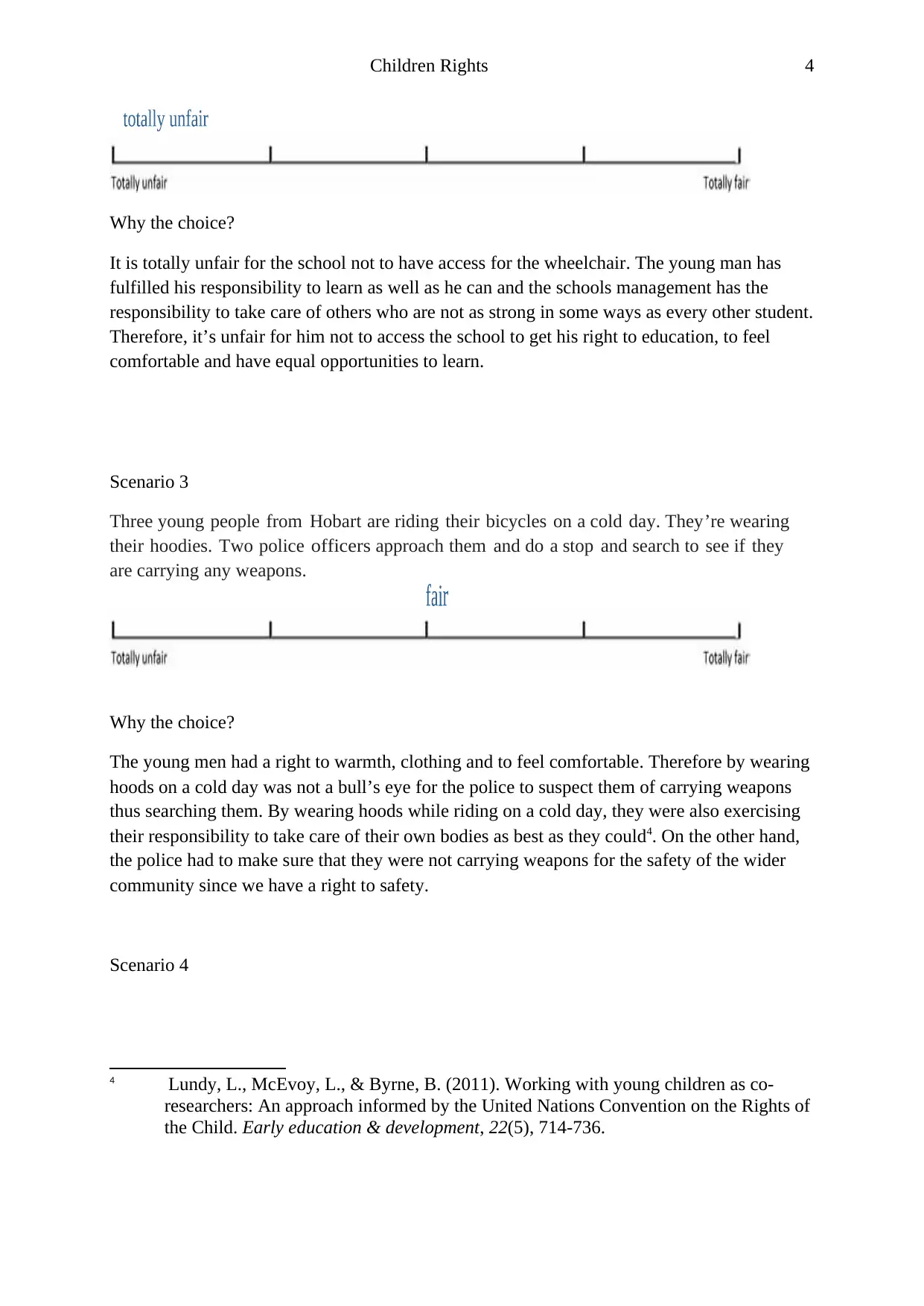
Children Rights 4
Why the choice?
It is totally unfair for the school not to have access for the wheelchair. The young man has
fulfilled his responsibility to learn as well as he can and the schools management has the
responsibility to take care of others who are not as strong in some ways as every other student.
Therefore, it’s unfair for him not to access the school to get his right to education, to feel
comfortable and have equal opportunities to learn.
Scenario 3
Three young people from Hobart are riding their bicycles on a cold day. They’re wearing
their hoodies. Two police officers approach them and do a stop and search to see if they
are carrying any weapons.
Why the choice?
The young men had a right to warmth, clothing and to feel comfortable. Therefore by wearing
hoods on a cold day was not a bull’s eye for the police to suspect them of carrying weapons
thus searching them. By wearing hoods while riding on a cold day, they were also exercising
their responsibility to take care of their own bodies as best as they could4. On the other hand,
the police had to make sure that they were not carrying weapons for the safety of the wider
community since we have a right to safety.
Scenario 4
4 Lundy, L., McEvoy, L., & Byrne, B. (2011). Working with young children as co-
researchers: An approach informed by the United Nations Convention on the Rights of
the Child. Early education & development, 22(5), 714-736.
Why the choice?
It is totally unfair for the school not to have access for the wheelchair. The young man has
fulfilled his responsibility to learn as well as he can and the schools management has the
responsibility to take care of others who are not as strong in some ways as every other student.
Therefore, it’s unfair for him not to access the school to get his right to education, to feel
comfortable and have equal opportunities to learn.
Scenario 3
Three young people from Hobart are riding their bicycles on a cold day. They’re wearing
their hoodies. Two police officers approach them and do a stop and search to see if they
are carrying any weapons.
Why the choice?
The young men had a right to warmth, clothing and to feel comfortable. Therefore by wearing
hoods on a cold day was not a bull’s eye for the police to suspect them of carrying weapons
thus searching them. By wearing hoods while riding on a cold day, they were also exercising
their responsibility to take care of their own bodies as best as they could4. On the other hand,
the police had to make sure that they were not carrying weapons for the safety of the wider
community since we have a right to safety.
Scenario 4
4 Lundy, L., McEvoy, L., & Byrne, B. (2011). Working with young children as co-
researchers: An approach informed by the United Nations Convention on the Rights of
the Child. Early education & development, 22(5), 714-736.
Paraphrase This Document
Need a fresh take? Get an instant paraphrase of this document with our AI Paraphraser
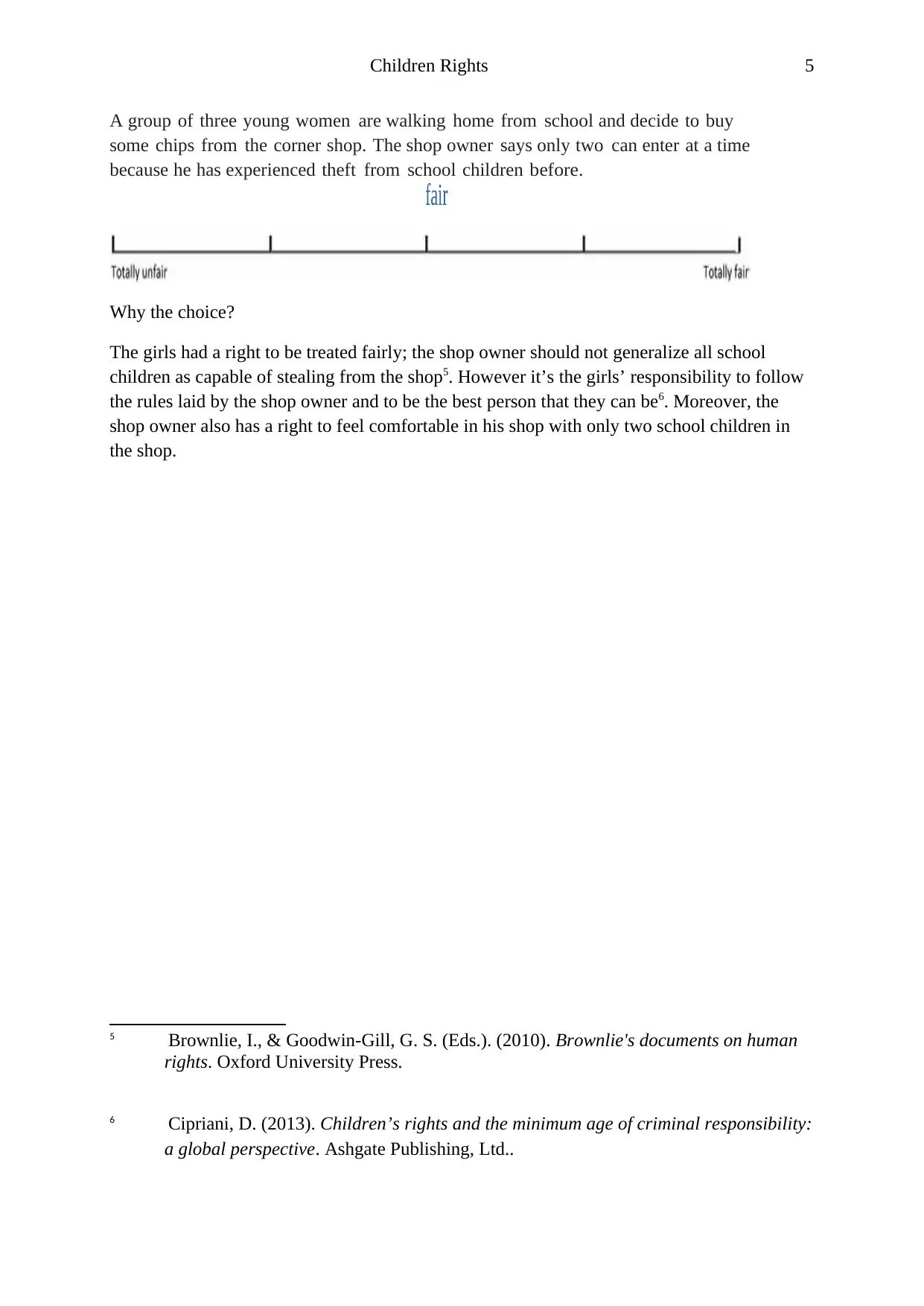
Children Rights 5
A group of three young women are walking home from school and decide to buy
some chips from the corner shop. The shop owner says only two can enter at a time
because he has experienced theft from school children before.
Why the choice?
The girls had a right to be treated fairly; the shop owner should not generalize all school
children as capable of stealing from the shop5. However it’s the girls’ responsibility to follow
the rules laid by the shop owner and to be the best person that they can be6. Moreover, the
shop owner also has a right to feel comfortable in his shop with only two school children in
the shop.
5 Brownlie, I., & Goodwin-Gill, G. S. (Eds.). (2010). Brownlie's documents on human
rights. Oxford University Press.
6 Cipriani, D. (2013). Children’s rights and the minimum age of criminal responsibility:
a global perspective. Ashgate Publishing, Ltd..
A group of three young women are walking home from school and decide to buy
some chips from the corner shop. The shop owner says only two can enter at a time
because he has experienced theft from school children before.
Why the choice?
The girls had a right to be treated fairly; the shop owner should not generalize all school
children as capable of stealing from the shop5. However it’s the girls’ responsibility to follow
the rules laid by the shop owner and to be the best person that they can be6. Moreover, the
shop owner also has a right to feel comfortable in his shop with only two school children in
the shop.
5 Brownlie, I., & Goodwin-Gill, G. S. (Eds.). (2010). Brownlie's documents on human
rights. Oxford University Press.
6 Cipriani, D. (2013). Children’s rights and the minimum age of criminal responsibility:
a global perspective. Ashgate Publishing, Ltd..
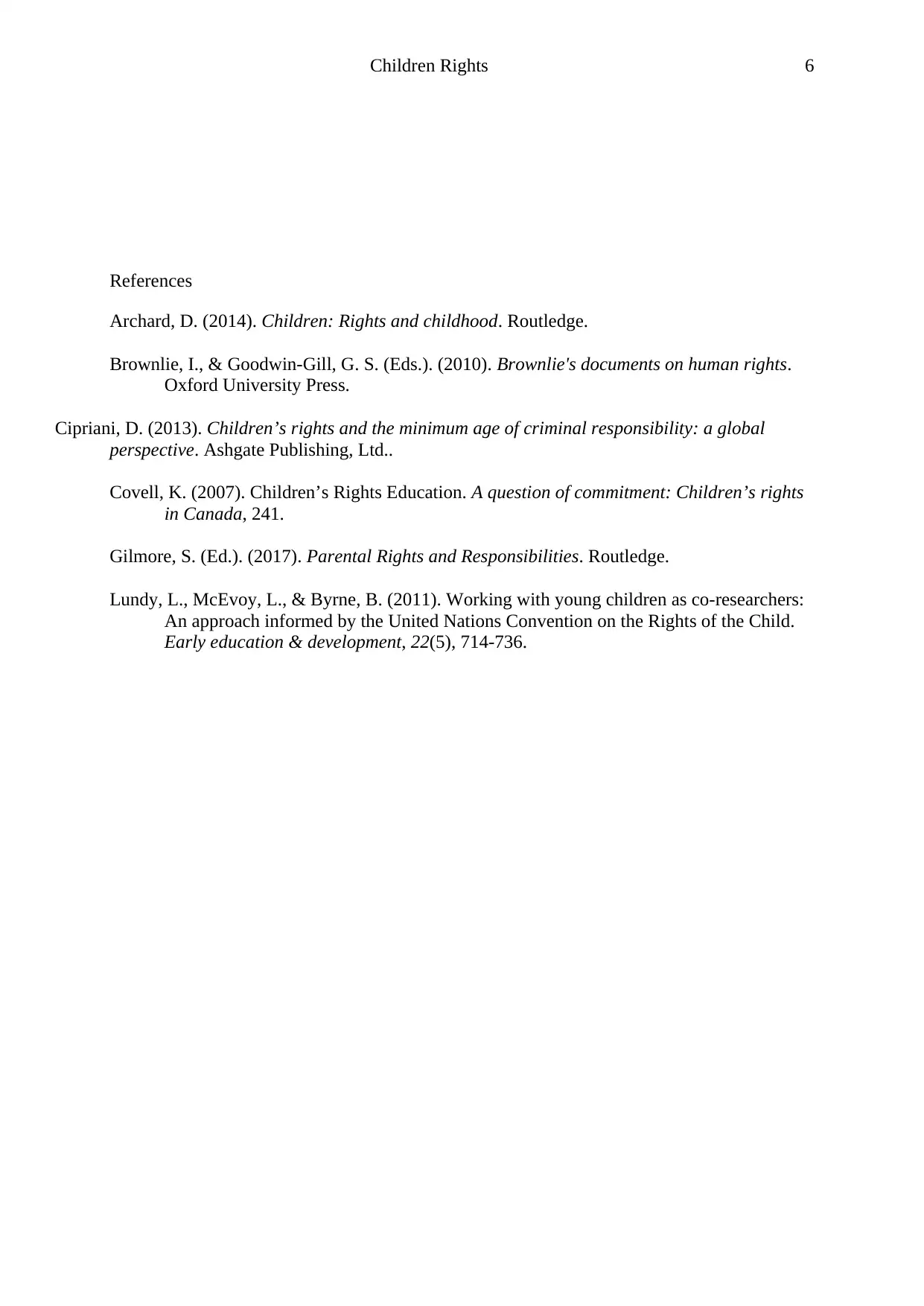
Children Rights 6
References
Archard, D. (2014). Children: Rights and childhood. Routledge.
Brownlie, I., & Goodwin-Gill, G. S. (Eds.). (2010). Brownlie's documents on human rights.
Oxford University Press.
Cipriani, D. (2013). Children’s rights and the minimum age of criminal responsibility: a global
perspective. Ashgate Publishing, Ltd..
Covell, K. (2007). Children’s Rights Education. A question of commitment: Children’s rights
in Canada, 241.
Gilmore, S. (Ed.). (2017). Parental Rights and Responsibilities. Routledge.
Lundy, L., McEvoy, L., & Byrne, B. (2011). Working with young children as co-researchers:
An approach informed by the United Nations Convention on the Rights of the Child.
Early education & development, 22(5), 714-736.
References
Archard, D. (2014). Children: Rights and childhood. Routledge.
Brownlie, I., & Goodwin-Gill, G. S. (Eds.). (2010). Brownlie's documents on human rights.
Oxford University Press.
Cipriani, D. (2013). Children’s rights and the minimum age of criminal responsibility: a global
perspective. Ashgate Publishing, Ltd..
Covell, K. (2007). Children’s Rights Education. A question of commitment: Children’s rights
in Canada, 241.
Gilmore, S. (Ed.). (2017). Parental Rights and Responsibilities. Routledge.
Lundy, L., McEvoy, L., & Byrne, B. (2011). Working with young children as co-researchers:
An approach informed by the United Nations Convention on the Rights of the Child.
Early education & development, 22(5), 714-736.
⊘ This is a preview!⊘
Do you want full access?
Subscribe today to unlock all pages.

Trusted by 1+ million students worldwide
1 out of 6
Related Documents
Your All-in-One AI-Powered Toolkit for Academic Success.
+13062052269
info@desklib.com
Available 24*7 on WhatsApp / Email
![[object Object]](/_next/static/media/star-bottom.7253800d.svg)
Unlock your academic potential
Copyright © 2020–2025 A2Z Services. All Rights Reserved. Developed and managed by ZUCOL.





